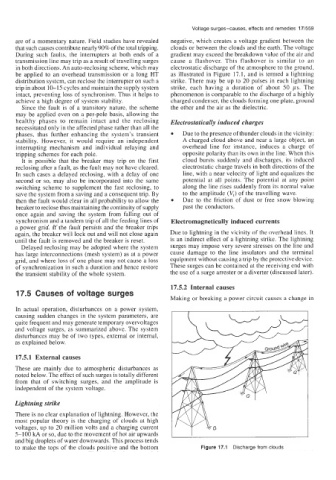Page 594 - Industrial Power Engineering and Applications Handbook
P. 594
Voltage surges-causes, effects and remedies 171559
are of a momentary nature. Field studies have revealed negative, which creates a voltage gradient between the
that such causes contribute nearly 90% of the total tripping. clouds or between the clouds and the each. The voltage
During such faults, the interrupters at both ends of a gradient may exceed the breakdown value of the air and
transmission line may trip as a result of travelling surges cause a flashover. This flashover is similar to an
in both directions. An auto-reclosing scheme, which may electrostatic discharge of the atmosphere to the ground,
be applied to an overhead transmission or a long HT as illustrated in Figure 17.1, and is termed a lightning
distribution system, can reclose the interrupter on such a strike. There may be up to 20 pulses in each lightning
trip in about 10-15 cycles and maintain the supply system strike, each having a duration of about 50 ps. The
intact, preventing loss of synchronism. Thus it helps to phenomenon is comparable to the discharge of a highly
achieve a high degree of system stability. charged condenser, the clouds forming one plate, ground
Since the fault is of a transitory nature, the scheme the other and the air as the dielectric.
may be applied even on a per-pole basis, allowing the
healthy phases to remain intact and the reclosing Electrostatically induced charges
necessitated only in the affected phase rather than all the
phases, thus further enhancing the system’s transient Due to the presence of thunder clouds in the vicinity:
stability. However, it would require an independent A charged cloud above and near a large object, an
interrupting mechanism and individual relaying and overhead line for instance, induces a charge of
tripping schemes for each pole. opposite polarity than its own in the line. When this
It is possible that the breaker may trip on the first cloud bursts suddenly and discharges, its induced
reclosing after a fault, as the fault may not have cleared. electrostatic charge travels in both directions of the
In such cases a delayed reclosing, with a delay of one line, with a near velocity of light and equalizes the
second or so, may also be incorporated into the same potential at all points. The potential at any point
switching scheme to supplement the fast reclosing, to along the line rises suddenly from its normal value
save the system from a saving and a consequent trip. By to the amplitude (V,) of the travelling wave.
then the fault would clear in all probability to allow the Due to the friction of dust or free snow blowing
breaker to reclose thus maintaining the continuity of supply past the conductors.
once again and saving the system from falling out of
synchronism and a tandem trip of all the feeding lines of Electromagnetically induced currents
a power grid. If the fault persists and the breaker trips
again, the breaker will lock out and will not close again Due to lightning in the vicinity of the overhead lines. It
until the fault is removed and the breaker is reset. is an indirect effect of a lightning strike. The lightning
Delayed reclosing may be adopted where the system surges may impose very severe stresses on the line and
has large interconnections (mesh system) as at a power cause damage to the line insulators and the terminal
grid, and where loss of one phase may not cause a loss equipment without causing a trip by the protective device.
of synchronization in such a duration and hence restore These surges can be contained at the receiving end with
the transient stability of the whole system. the use of a surge arrester or a diverter (discussed later).
17.5.2 Internal causes
17.5 Causes of voltage surges
Making or breaking a power circuit causes a change in
In actual operation, disturbances on a power system,
causing sudden changes in the system parameters, are
quite frequent and may generate temporary overvoltages
and voltage surges, as summarized above. The system
disturbances may be of two types, external or internal,
as explained below.
17.5.1 External causes
These are mainly due to atmospheric disturbances as
noted below. The effect of such surges is totally different
from that of switching surges, and the amplitude is
independent of the system voltage.
Lightning strike
There is no clear explanation of lightning. However, the
most popular theory is the charging of clouds at high
voltages, up to 20 million volts and a charging current
5-100 kA or so, due to the movement of hot air upwards
and big droplets of water downwards. This process tends
to make the tops of the clouds positive and the bottom Figure 17.1 Discharge from clouds

